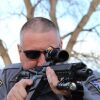I’ve always wondered why it took so long for law enforcement to accept two-handed shooting. We’re a stubborn bunch. As late as the 1950s, what is now addressed as “strong-hand-only” shooting was still the primary method being widely taught to young coppers. I wonder if mid-century gun scribes wrote controversial articles like “One Hand vs. Two Handed Shooting” or “It’s a Handgun not a Handsgun” like the more recent and all-too-frequent “9mm vs. 45,” write-ups.
Two hands are better than one, in case anyone was wondering. Though Jack Weaver isn’t primarily known for being one of the first people credited with two-fisted pistoling, it’s at least one of the reasons he was hotter than doughnut grease in the California “Leather Slap” matches of his era. It wasn’t long before others followed his example and saw similar improvement in their shooting skills.
Without Darkness
Unlike most professions, police officers can’t predict their working environment from one moment to the next. A street cop might experience a well-lighted office, a pitch-black abandoned warehouse or the proverbial dark alley in the same shift. With that, the flashlight is nearly as common to the police uniform as the gun and badge. Somebody or somebodies had the brilliance to combine two good things: gun and light. Oddly, the weapon-mounted light (WML) is the subject of some controversy. Discussions of weapon lights often devolve into a debate of weapon lights versus handheld lights. I find that puzzling. The addition of a WML does not require a cop to discard his stand-alone flashlight. That would be inane. Weapon lights are a supplement to – not a replacement of – the flashlight and duty pistol.
Rule #2 is a Thing
One argument against WML is that whatever is illuminated by a pistol light is also covered by the muzzle. This point is dependent upon the assumption that the officer will be using his or her pistol light in place of the flashlight when it isn’t appropriate to do so. Hopefully, it’s obvious that firearms safety rule #2 always applies.
Still, the reason we have any sort of white light at all is to gather information we don’t have – like who is a threat and who isn’t. In that vast grey area between where a firearm is needed and where it is entirely inappropriate is where cops operate most of the time. There is an underused technique that might be appropriate in some situations. The “spill” of the WML can be used to illuminate an area while keeping the firearm in a low-ready position. That’s not perfect for every occasion, but I’ve found it viable during force on force training in low light.
Rule #3 is a Thing
Another concern about weapon lights is that the activation switch is very close to the trigger and many unintentional (negligent, accidental or whatever the cool kids are calling it these days) discharges have been indirectly attributed to WMLs. Officers who train to use their trigger finger to activate the light are the most common perpetrators. It’s just not fair to give a single digit two very different jobs to do. It’s recommended to use the offside thumb to activate the WML under most conditions.
Undoubtedly, the single most important factor in considering a WML is weapon reliability. Adding a weapon light to some pistols can negatively affect function due to a change in slide velocity. It took a lot of smart folks to balance that delicate ballet of magic that goes on inside a properly functioning semi-automatic pistol. It shouldn’t be surprising that it doesn’t take much tweaking to turn a gun that once ran like a sewing machine into one that runs like a streaming video on a dial-up connection.
As always, test your duty pistol thoroughly with your chosen WML and defensive ammunition prior to trusting the combination in the field. Most quality pistol manufacturers have addressed this concern very well over the last several years and it’s not as much of an issue these days.
Two Hands Are Better Than One
With all that said, the greatest attribute of the WML is that it allows for a normal two-handed grip on the pistol. Who isn’t faster and more accurate with both hands on their pistol? Whatever detractions pistol lights have can be overcome. I would go as far as to say there is no solid reason for today’s street cop to be without one. I’d like to think Mr. Weaver would agree.



